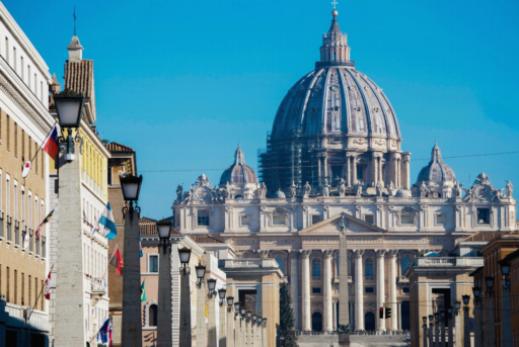The Monument to Pope Urban VIII stands as a significant symbol of Baroque art and a controversial piece in Vatican City. Featuring intricate iconography and rich symbolism, the monument has sparked debates and restoration efforts over the years. Its influence on Baroque art is undeniable, showcasing the artistic legacy of Pope Urban VIII and his lasting impact on the artistic landscape of the time.

Symbolism and Iconography of the Monument to Pope Urban VIII
The Monument to Pope Urban VIII, located in St. Peter's Basilica in Vatican City, is a significant piece of Baroque art that is rich in symbolism and iconography. Designed by Gian Lorenzo Bernini, this monument is a complex and intricate representation of the pontiff's legacy and authority.
One of the most prominent symbols featured in the monument is the bronze figure of Pope Urban VIII himself, seated in a majestic throne and wearing the papal tiara and robes. This representation emphasizes the pope's power and importance within the Catholic Church.
Additionally, the monument is adorned with various allegorical figures, such as Charity, Prudence, Justice, and Truth. These figures serve to convey the virtues and principles that Pope Urban VIII upheld during his papacy, highlighting his commitment to faith and righteousness.
The inclusion of a winged figure of Death holding an hourglass serves as a reminder of the transient nature of life and the inevitability of death, emphasizing the pope's mortality despite his lofty position.
Overall, the Monument to Pope Urban VIII is a masterful example of Baroque art that employs symbolism and iconography to convey the religious and political significance of the pontiff. Through its intricate design and meticulous detailing, this monument stands as a testament to the power and influence of Pope Urban VIII during his reign.
Controversies Surrounding the Monument to Pope Urban VIII
The Monument to Pope Urban VIII, located in St. Peter's Basilica in Vatican City, has been the subject of controversy since its inception. One of the main sources of contention is the extravagant nature of the monument, with some critics arguing that it is overly opulent and ostentatious. Additionally, there have been accusations that the monument was built at the expense of the poor and marginalized members of society, further fueling the controversy surrounding it.
Another point of contention is the inclusion of allegorical figures in the monument, which some have interpreted as being inappropriate for a religious setting. These figures, which are meant to represent various virtues and aspects of Pope Urban VIII's reign, have been criticized for their depictions and perceived lack of reverence.
Furthermore, there have been debates about the placement of the monument within St. Peter's Basilica, with some arguing that it detracts from the overall aesthetic of the church and disrupts the sacred atmosphere. There have even been calls for the monument to be relocated or removed entirely, although these proposals have yet to be acted upon.
Overall, the controversies surrounding the Monument to Pope Urban VIII highlight the complex and sometimes contentious nature of public art and monuments, particularly within the context of religious spaces. Despite these criticisms, the monument remains a significant and enduring symbol of Pope Urban VIII's legacy.
Restoration Efforts for the Monument to Pope Urban VIII
Peter's Basilica in Vatican City, has undergone various restoration efforts over the years to ensure its preservation for future generations. The monument, created by the renowned artist Gian Lorenzo Bernini in the 17th century, is a masterpiece of Baroque art and a significant historical and cultural landmark.
One of the main restoration projects for the Monument to Pope Urban VIII took place in the late 20th century, with the goal of addressing the effects of aging, pollution, and previous restoration attempts. Conservation experts carefully cleaned the marble surfaces, repaired any damage, and stabilized the structure to prevent further deterioration. This meticulous process required in-depth research, skilled craftsmanship, and a deep understanding of the monument's historical and artistic significance.
In addition to physical restoration work, efforts were also made to document and analyze the monument's condition before, during, and after the restoration process. Advanced imaging techniques, scientific analysis of materials, and archival research helped conservationists gain valuable insights into the monument's construction, alterations, and conservation history. This comprehensive approach ensured that the restoration efforts were based on a thorough understanding of the monument's artistic, historical, and structural aspects.
Thanks to these restoration efforts, the Monument to Pope Urban VIII has been preserved as a lasting testament to the artistic mastery of Bernini and the Baroque era. The conservation work not only ensures the monument's physical integrity but also allows future generations to appreciate its beauty, symbolism, and historical significance. The restoration efforts serve as a crucial component in safeguarding this iconic monument for years to come.
Influence of the Monument to Pope Urban VIII on Baroque Art
The Monument to Pope Urban VIII, created by Gian Lorenzo Bernini, is a significant example of Baroque art that has had a lasting impact on the art movement. This masterpiece showcases the dynamic and dramatic style that came to define Baroque art in the 17th century. Bernini's innovative use of light, space, and emotion in the monument influenced numerous artists of the Baroque era and beyond. The monument's intricate details and realistic portrayal of the human form set a new standard for sculpture during this period. Additionally, the composition and movement of the figures in the monument demonstrate a mastery of the Baroque aesthetic, inspiring countless artists to explore similar themes in their own works. Ultimately, the Monument to Pope Urban VIII stands as a testament to the profound influence that this artwork has had on the development of Baroque art.
